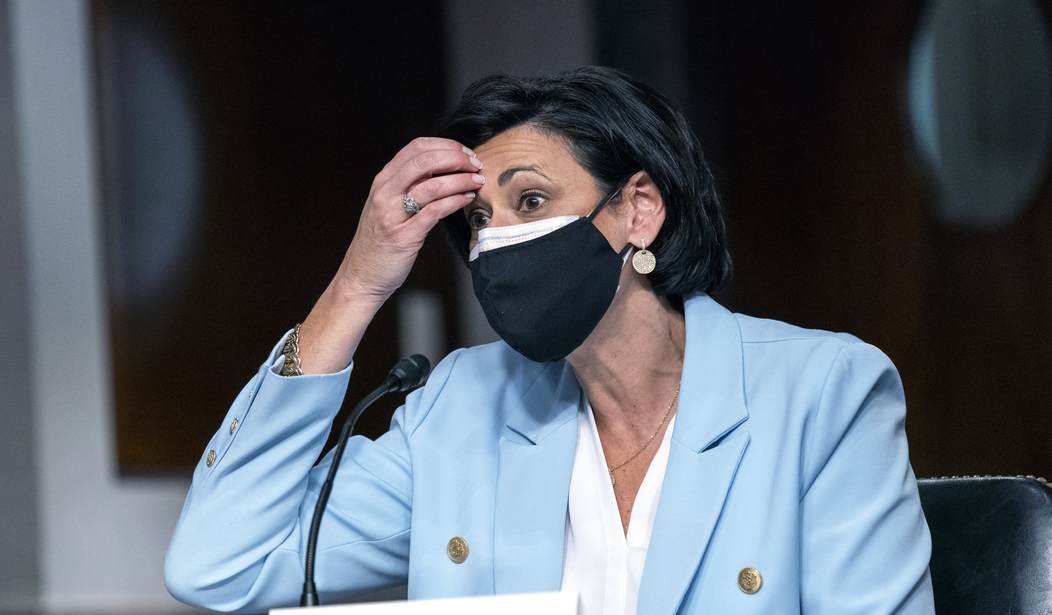Joe Biden’s Supreme Court pick might only come in second place for eagerly awaited and overdue announcements today. Weeks after most Democrat governors abandoned the CDC’s masking guidelines in the face of voter revolts, the CDC may announce as early as today that the science has changed.
The political science, that is:
The Centers for Disease Control and Prevention will soon loosen its mask guidelines by weighing metrics such as hospital capacity and coronavirus admissions, rather than simply looking at case counts, so more people can feel comfortable going maskless in indoor public spaces, according to two senior administration officials and two people familiar with the plans.
The change comes weeks after numerous states, including those led by Democratic governors, announced plans to lift mandates as omicron cases drop sharply. But states have long been pressing the agency for better guidelines to inform their decisions to ease restrictions, the officials said.
Translation: Democratic governors and mayors have begged the CDC for some political cover for their retreat. That followed months of demands from executives of both parties for the CDC to clearly define the metrics that require masking and objective measures that would allow them to ease such mandates. The CDC instead kept refusing to specify either a data set metric or the science that demonstrated the need for masking, especially in schools.
That may change long after the horse has escaped the barn, but as soon as today:
The CDC could announce the new guidelines as soon as Friday, according to the Associated Press. A CDC spokeswoman declined to say when the CDC would announce its updated guidance.
Under existing CDC guidelines, more than 96 percent of counties are still considered substantial or high transmission for the coronavirus, meaning the agency recommends masking in most indoor settings.
The new CDC guidelines will look not only at case counts, but at severity of disease, by factoring in hospitalizations and hospital capacity, two of the officials said — a change that state health officials have welcomed.
The CDC’s effort on that front is notable, too. We have had CDC data on hospitalizations for most of the pandemic, as well as overall case counts (which suffer from testing-supply failures) and deaths. Hospitalizations and deaths, however, include any correlated to COVID-19. The CDC refused to narrow reporting on such data to causative hospitalizations and deaths, even long after that problem was known and continuing long past the point when vaccinations and exposure made the disconnect between correlation and causation even wider. Omicron exposed that issue utterly too, so much so that Anthony Fauci had to address it two months ago when pediatric admissions with COVID-19 peaked.
The CDC announced earlier this month that they would start requiring causation for reported admissions and deaths, a plan that they still haven’t put in place. Why did it take almost two years for the CDC to focus on causation? High numbers served administration policies on mandates, for one thing, although a sunk-cost approach to consistent-if-inaccurate metrics probably played a part in that inertia as well. Suddenly, though, high numbers have become a major political problem for Democrats, which is why the CDC suddenly changed course on causation. They wanted to start producing lower numbers that narrowly focused on the real impact on public health from COVID-19 as a way to offer a dramatic off-ramp once the public revolt against masking began in earnest.
They can’t really cite their own data to explain a shift now. That data has made it clear that unmasking risks have been exceedingly low in the Omicron wave, especially with children.
It’s too late for that kind of political cover now, though. The CDC will have to revise its guidelines even with the higher correlative numbers, which will be much tougher to explain. At least we’ll finally see public policy going in the right direction, even if the CDC’s politicization has entirely squandered public trust in its pandemic management.








Join the conversation as a VIP Member